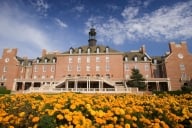You have /5 articles left.
Sign up for a free account or log in.
By wading into the highly contentious issue of Native American nicknames and mascots for college sports teams on Friday, National Collegiate Athletic Association leaders achieved their stated aim of sending a clear message that they object to such imagery. But the NCAA also created a cacophony of confusion and put the association in the potentially uncomfortable position of judging when Native American references are “hostile” and “abusive” and when they’re not – questions that could take months, and possibly help from the courts, to resolve.
Four years after the NCAA began looking into the subject, its executive committee announced that beginning in February, it would limit participation in its own postseason championships for 18 colleges and universities with Native American mascots, nicknames or other imagery that the association deemed "hostile and abusive."
The NCAA said that (1) it would no longer let such institutions play host to its national tournaments; (2) colleges already scheduled to sponsor such events would have to eliminate any references to the Indian imagery from the arenas or stadiums; (3) such colleges could not bring mascots, cheerleaders or any other people or paraphernalia that feature Native American imagery to NCAA championships, beginning in 2008; and (4) athletes may not wear uniforms or other gear with "hostile and abusive" references at NCAA tournament events. (The NCAA’s actions don’t directly affect bowl games, which the association does not control, or anything that happens in the regular season.)
NCAA officials, whom critics of Native American mascots had hoped would ban such imagery altogether, said they had tried to strike a middle ground, condemning its use but acknowledging the autonomy and independence of the association's member colleges. "An institution may adopt whatever mascot it wishes -- that's an institutional matter, and it involves their integrity and autonomy as institutions," said Walter Harrison, president of the University of Hartford and chairman of the NCAA's executive committee, its chief governing panel.
"But obviously we find that these hostile or abusive mascots or nicknames are troubling to us," he added, "and we take these measures that affect NCAA championships, which are within our authority. We're trying to send a message very strongly."
Not everyone bought the NCAA's argument that it was respecting the authority of its members. Some told the NCAA to butt out of its business -- and did so in ferocious terms.
Florida State University T. K. Wetherell, who had announced this summer that the Seminole Tribe of Florida had signed off on its Seminole nickname and its use of an Indian's head logo, called the NCAA's actions "outrageous and insulting." "I intend to pursue all legal avenues to ensure that this unacceptable decision is overturned, and that this university will forever be associated with the 'unconquered' spirit of the Seminole Tribe of Florida," Wetherell said in a written statement.
NCAA officials did not respond directly to Florida State's statement, but in the news conference in which it announced the new policy, Charlotte Westerhaus, an NCAA official, said that branches of the Seminole tribe elsewhere in the country objected to use of tribe's name. Harrison, speaking hypothetically, also said: "Everyone has recourse through the courts. We think this is a very reasoned and solid approach that governs those things that we control. But we would be prepared to defend that if actions were brought against us."
Most other officials at the colleges on the NCAA's "wanted list" expressed a mixture of aggravation and concern, leavened most of all by confusion over what standards the association had used in coming up with its list and how the restrictions might apply should the colleges decide to retain their Indian imagery.
"There are a lot of unanswered questions raised by the NCAA's conference call this morning and the release it put out this afternoon," Thomas Hardy, executive director of university relations for the University of Illinois System, said in an interview Friday. Some students, faculty members and others at Illinois's Urbana-Champaign campus have been pushing the university for nearly 15 years to abandon its Chief Illiniwek mascot, which supporters have fought hard to keep. "We're going to review what the NCAA has recommended today and will make some determination as to how that impacts our policy."
Charles E. Kupchella, president of the University of North Dakota, whose Fighting Sioux name and logo have been accused of furthering a racist stereotype, said in an interview that the NCAA had not made clear what it had determined was "offensive" about the university's imagery or how it had done so.
" 'Hostile and abusive' is not defined, and we do not know who says, and by what standard," Kupchella said. "Our athletes and coaching staff have used the nickname and a logo, designed by an American Indian artist, with great pride and respect."
Confusion Reigns
In a news conference and subsequent press release announcing the new policy, the NCAA provided little clarity, and in fact may have sowed additional confusion.
Westerhaus, the association's vice president for diversity and inclusion, said the NCAA had drawn up its list of offending colleges by reviewing self-studies submitted by more than 30 institutions and applying a definition of "hostile and abusive" that it drew from its own policies and from "case law" and other sources.
During the news conference, Myles Brand, the NCAA's president, suggested that the NCAA could conclude that some institutions were using Native American names in a way that was not abusive or hostile. He noted, for example, that the NCAA had kept the University of North Carolina at Pembroke off the endangered list, despite its Braves nickname and its logo of an Indian brave (with a red-tailed hawk), because more than 20 percent of its students are Native American. He said other colleges had Native American nicknames that were not "being used hostilely or abusively."
But the news release the NCAA issued later in the day seemed to conflict with that statement by dividing the colleges into two major categories. Eighteen "continue to use Native American imagery or references and are subject to the new policy." (One other institution, the College of William and Mary, received an extension of time to submit its defense of its Tribe nickname.)
Another 14 have "removed all references to Native American culture or were deemed not to have references to Native American culture as part of their athletics programs" -- in other words, nicknames (like Braves or Warriors) that sound like Indian names but either never had or no longer have a link to Native American culture. (For example, the NCAA accepted San Diego State University’s argument that its Aztec nickname and warrior mascot were not linked to any organized tribe in the U.S. or Mexico.) The NCAA’s statement suggests, therefore, that any use of a Native American name or mascot that is linked directly to Indian culture will be deemed "hostile and abusive."
NCAA officials did not respond to a request Friday to clarify that apparent discrepancy and to further explain the standards they had used to decide which mascots and names were "hostile and abusive."
That and other issues are likely to be adjudicated through the NCAA's internal decision making procedures or, if colleges don't get satisfactory resolutions there, through the courts.
One of the first institutions to have to confront the new policy is the University of North Dakota. Next March, the Western regional portion of the NCAA Division I men’s ice hockey tournament is scheduled to be held in the university's Ralph Engelstad Arena, which features a large image of the Fighting Sioux logo atop its entrance (plus a statue of Indian on horseback in its plaza).
Kupchella, North Dakota's president, wondered how the university might have to "reengineer" the arena to satisfy the NCAA. "Are we talking about taping something over? Taking signs off the building? Do you have to grind off the granite" every place the word "Sioux" appears? he wondered.
He and other college officials wrestled with slightly broader questions, too, occasioned by the NCAA's new policy. Had the NCAA respected its members autonomy, as its officials suggested, or had the association overstepped its bounds?
Kupchella blurted out a laugh, then paused. "The handbook for presidents," he said, "tells you not to respond to what's still a hypothetical."
Others not in the potential line of fire were less reticent. Steve Denson, a member of the Chickasaw Nation who is director of diversity and an adjunct professor at Southern Methodist University's Cox School of Business, said he believed that the NCAA, with its advocacy, might have done a favor to institutions that have encountered alumni and donor opposition to eliminating Native American mascots. "In some ways the NCAA is creating a favorable political climate for schools to go back to their patrons and say, 'The NCAA is making us get rid of it,' " he said.
But Denson, who said he believes Native American nicknames such as Seminoles and Utes are acceptable when local tribes approve of them, also wondered if the mascot question really warrants the NCAA's time and energy.
"The majority of American Indians I know say that compared to poverty on reservations and other issues we deal with every day that are challenging to our very existence," Denson said, "this is a very secondary issue."
For the following colleges, though, the NCAA’s actions Friday are likely to keep the issue front and center for some time:
- Alcorn State University (Braves)
- Arkansas State University (Indians)
- Bradley University (Braves)
- Carthage College (Redmen)
- Catawba College (Indians)
- Central Michigan University (Chippewas)
- Chowan College (Braves)
- Florida State University (Seminoles)
- Indiana University of Pennsylvania (Indians)
- McMurry University (Indians)
- Midwestern State University (Indians)
- Mississippi College (Choctaws)
- Newberry College (Indians)
- Southeastern Oklahoma State University (Savages)
- University of Illinois at Urbana-Champaign (Illini)
- University of Louisiana-Monroe (Indians)
- University of North Dakota (Fighting Sioux)
- University of Utah (Utes)









